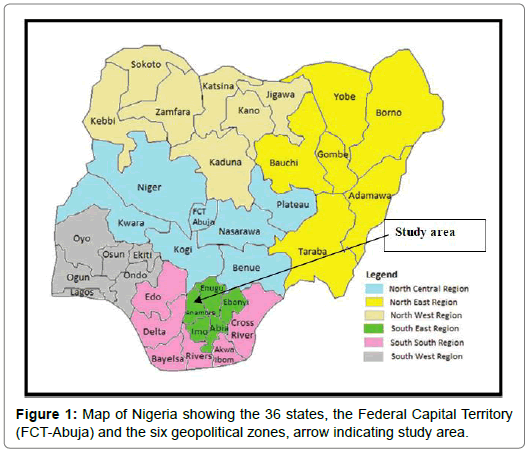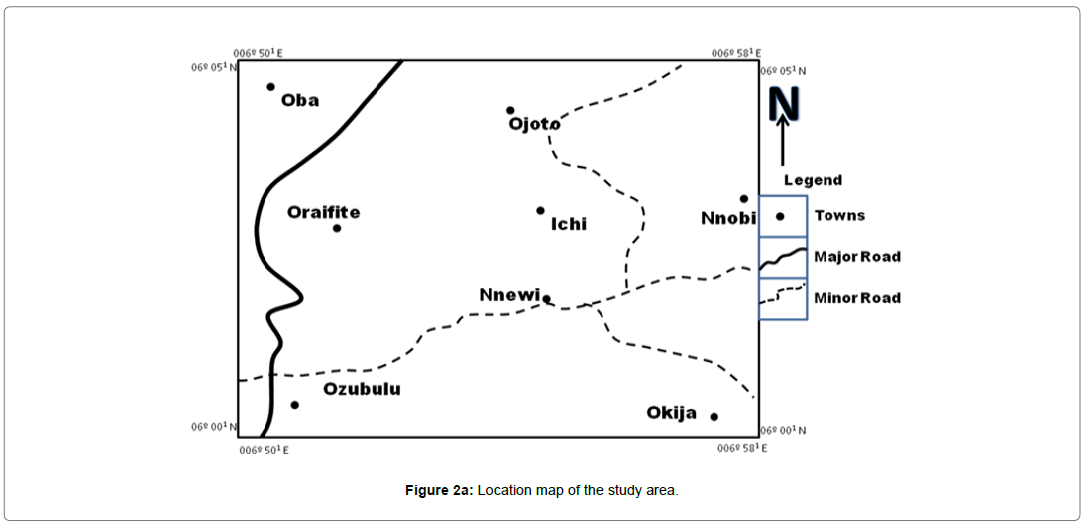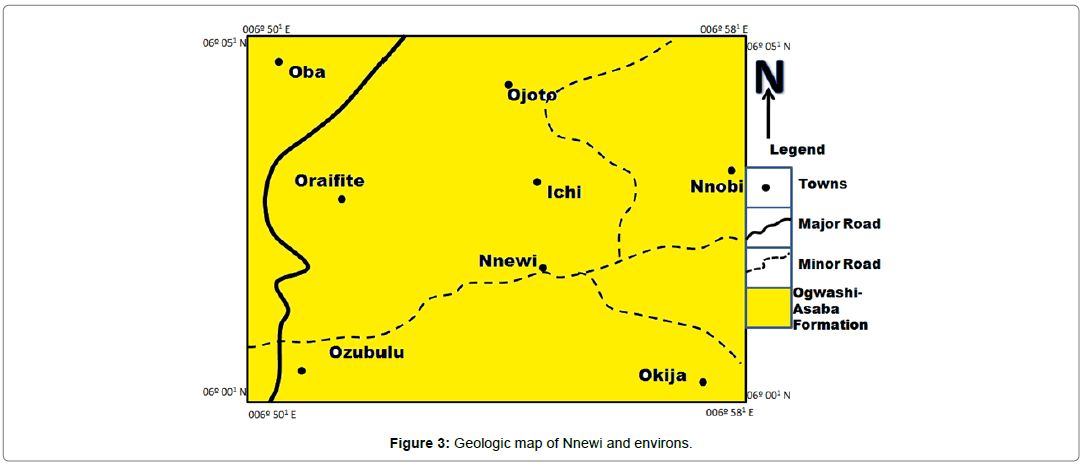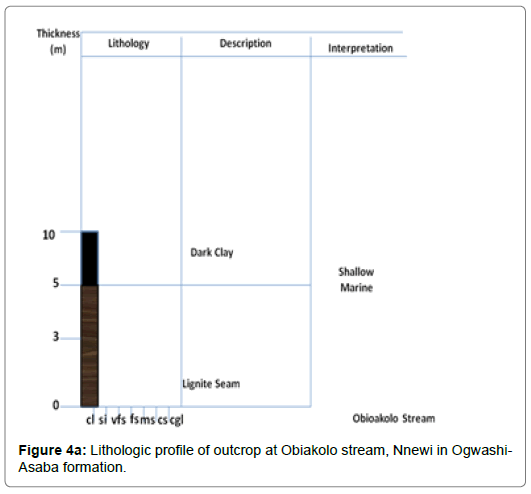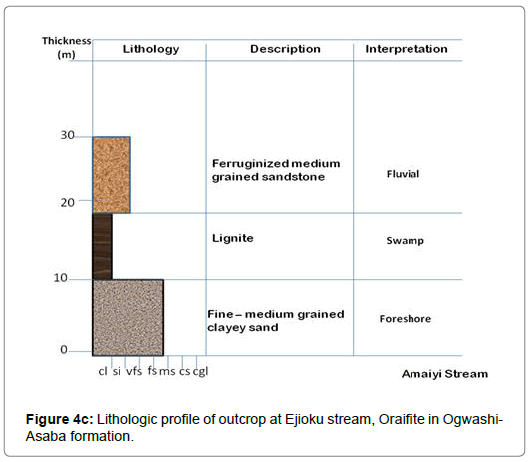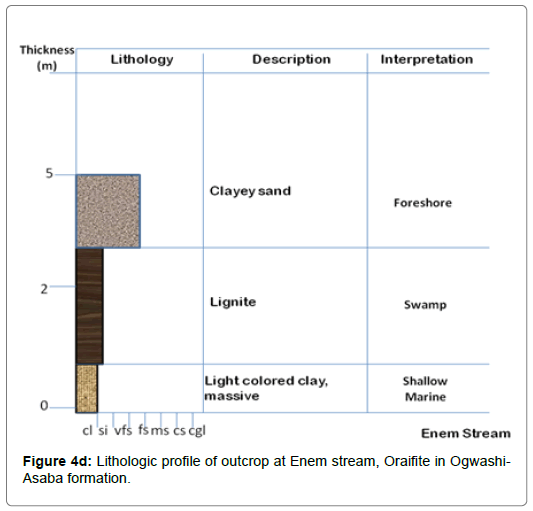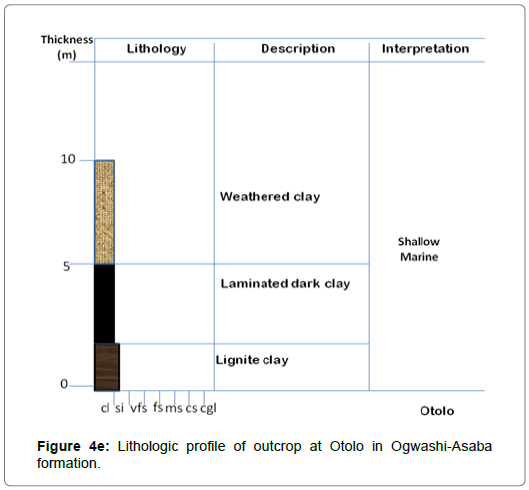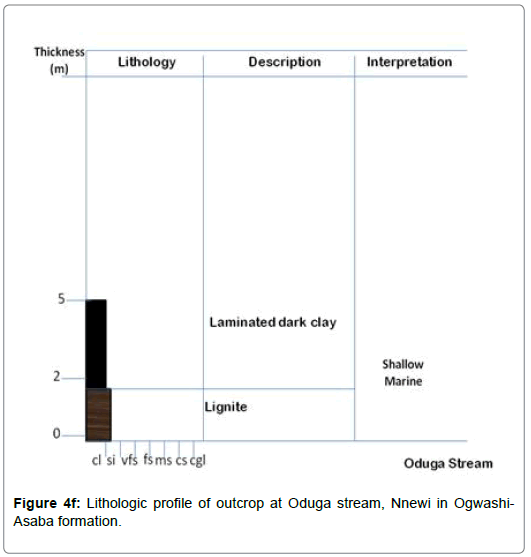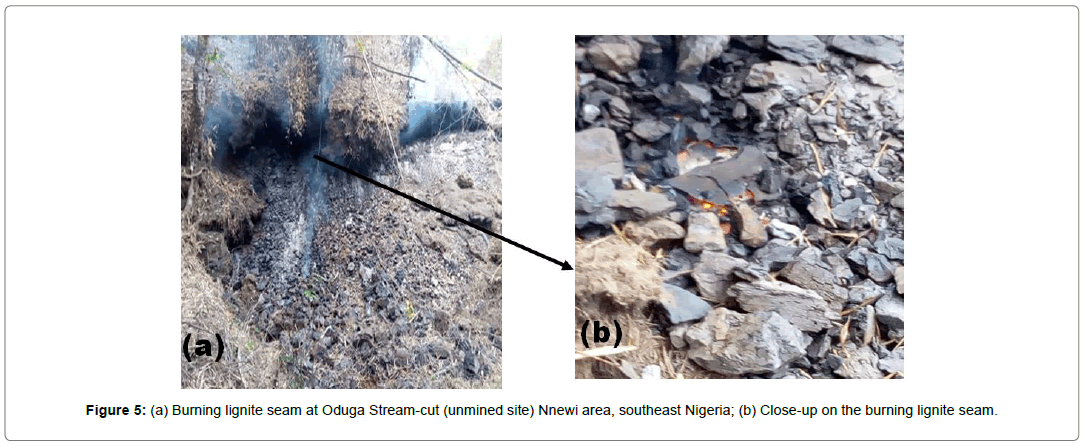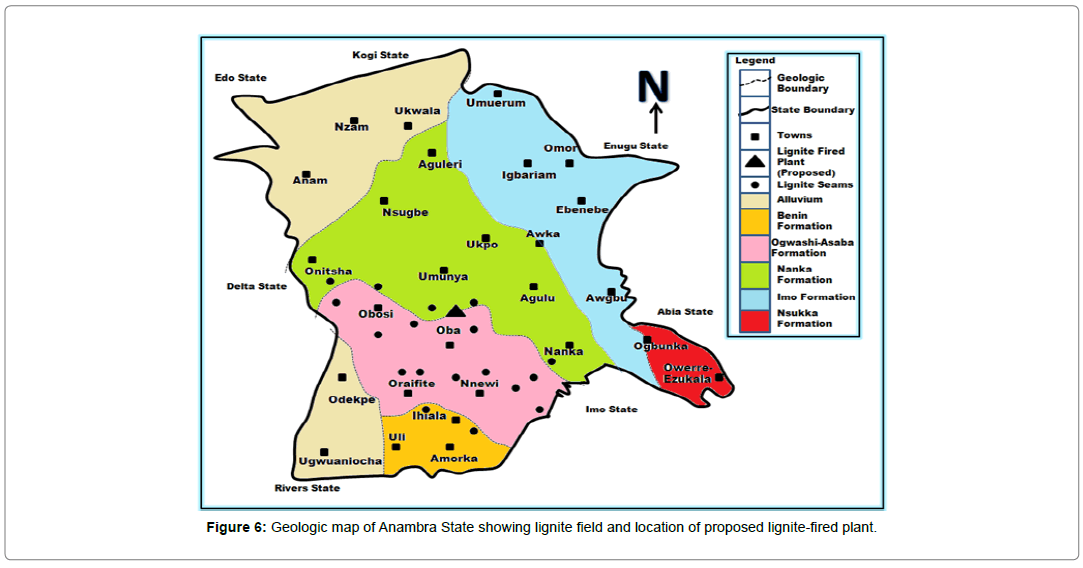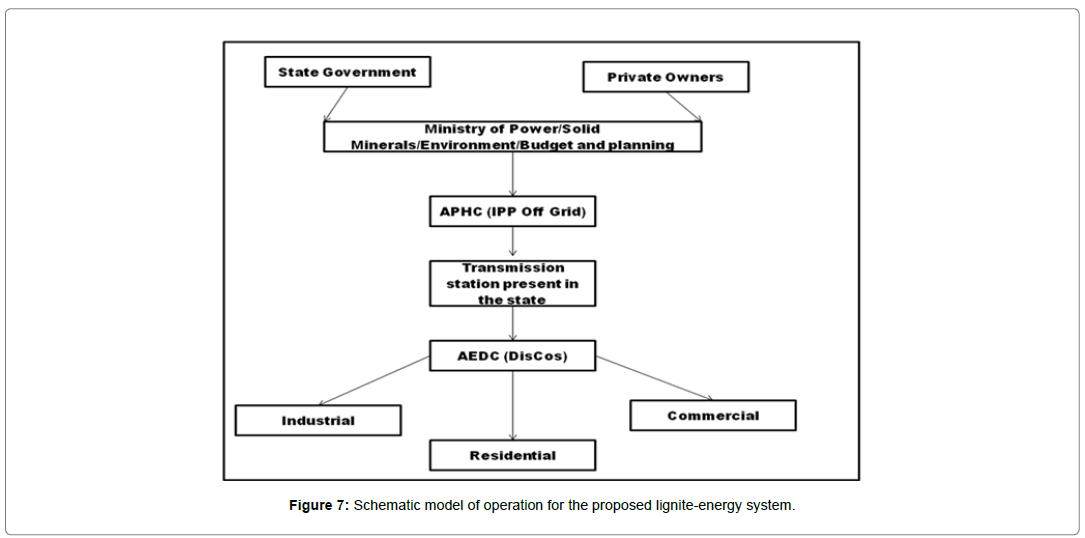The Tertiary Blessing and the Recent Neglects: A Case Study of the Anambra Lignite Energy Resource of Southeastern Nigeria
Received: 15-Apr-2019 / Accepted Date: 26-Apr-2019 / Published Date: 03-May-2019
Abstract
Lignite is the lowest rank of coal; its deposits found within the Paleogene Anambra Basin are Tertiary in age. They occur within the uppermost stratum of the Eocene Ameki Group, the Oligocene Ogwashi-Asaba Formation and the basal part of the Miocene Benin Formation. Energy is considered as one of the fundamental resources for industrialization. The current situation in Anambra State is that energy demand is greater than energy supply; this forms the basis of this research. Lignite can play an important role for power generation in Anambra State as a domestic resource that will be proximally available. Anambra State is enriched with substantial lignite deposits, but these deposits are currently under fire attack, which if not tackled will result in total loss of the deposits and unimaginable geologic hazards. The lignite seam fires were examined; the causes and possible solutions were documented. Strategies for sustainable exploitation and harnessment of this resource were also enumerated, which when properly implemented will solve the energy problem facing the State, thereby enhancing its socioeconomic status and also create opportunities for investments, employment and national development.
Keywords: Lignite seam fire; Paleogene Anambra Basin Ogwashi- Asaba formation; Anambra State; Power generation; National development; Spontaneous combustion; Sustainable exploitation
Introduction
Anambra is one of the 36 states of the Federal Republic of Nigeria and is located in the southeast geo-political zone of the country (Figure 1) [1]. The industrial sector of the state is a fast growing one with major industrial hub and activities at and going on around Onitsha, Nnewi, Ekwulobia, Awka, Nkpor, Ogbaru and the proposed Orient Petroleum Refinery at Aguleri. Energy is considered as one of the fundamental resources for industrialization [2]. With a recent population of about 200 million people [3] and a current electric power generation of 30000 megawatts [4], the energy supply is yet to meet the energy demand of most Nigerian states. Lignite as a rank of coal can play an important part in electric power generation [5,6]. Anambra State is blessed with substantial amount of lignite and ligniferous deposits [7,8]. The lignite occur within the uppermost stratum of Eocene Ameki Group (Nanka Formation), Oligocene Ogwashi-Asaba Formation and the basal part of Miocene Benin Formation [9] all of which are in Paleogene section of Anambra sedimentary Basin and are outcropping within the state. The lignite blessing which was deposited in the Tertiary and ever since been neglected is recently under fire attack at the Oduga stream in Nnewi southeast of Nigeria. The paper has evaluated the recent lignite seam fires; the causes, solution and has provided strategies for sustainable exploitation of this resource which when properly implemented will inhibit further future environmental and geologic hazards and in turn solve the energy problem facing the state thereby fostering industrialization hence enhancing the socio-economic status of the people and resulting to national development.
Geographic and geologic setting
Study area (location and accessibility): The study area lies within the area bounded by latitudes 06º 001 N and 06º 051 N of the equator and Longitudes 006º 501 E and 006º 581 E of the Greenwich meridian with an area extent of about 123.3 km2 (Figure 2a). Major settlements include Oraifite, Nnewi, Oba, Ojoto, Okija and Ozubulu. The area is accessible through Nkpor-Nnobi road, Onitsha-Owerri expressway, Awka-Etiti – Ekwulobia road and Abatete-Alor road. The area under study is located in Anambra State of the Federal Republic of Nigeria.
Physiography and drainage: The prominent topographic feature in the area is Ukpo-Abagana-Oraukwu-Ichida-Orlu cuesta (Figure 2b) [10]. The cuesta in this area is characterized by undulating topography made up of highlands which consist of sandstone and the lowlands which consist of clay and shale. The highest elevation in the study area is 172 m. The dominant drainage pattern of this area is dendritic in nature. The drainage system of the study area is controlled by relief and rock type. The major water bodies that drain the area are; River Idemili, Ejioku Stream, Oduga Stream, Ulasi River and Emen Stream (Figure 2c).
Climate and vegetation: The research area lies within the tropics which is characterized by two seasons; rainy and dry season. Rainy season begins in April and last till October during which rainfall is very heavy. Total rainfall during this period ranges from 1600 mm to 1750 mm (Figure 2d) [11,12]. The dry season begins in November and last till March. The natural vegetation of the area is a tropical rainforest type (Figure 2d) [13], which has largely changed to derived savannah due to human activities such as farming, lumbering and socio-infrastructural development.
Regional tectonic and stratigraphic setting: The area under study is situated within Anambra Basin. The geology of Anambra Basin has been documented by several workers such as Agagu et al. and Nwajide [14,15]. The basin is a synclinal structure located at the southwestern edge of Benue Trough (Figure 2e). The Santonian Tectonic Event uplifted Abakaliki area of the trough and created Abakaliki Anticlinorium, resulting to the formation of Afikpo Synclinorium to the east and Anambra Basin to the west [16-18]. Stratigraphically, Anambra Basin comprises of 6000 km thick sediments of Campanian up to Tertiary age. The Campanian – Maastrichtian period saw deposition of Nkporo Group, Mamu, Ajali and Nsukka Formations [19,20]. The Imo Formation, Ameki Group (Nanka Formation) and Ogwashi-Asaba and Benin Formations were deposited into the basin during Tertiary period [21-25]. The Benin Formation progrades unto the surface of Anambra Basin (Table 1) [26].
| Basin | Geologic Time Scale | Formation | ||
|---|---|---|---|---|
| Period | Epoch | Ages Stage | ||
| Paleogene Anambra Basin | Recent | Quaternary | Pleistocene | Alluvium |
| Tertiary | Neogene | Pliocene | Benin Formation | |
| Miocene | ||||
| Paleogene | Oligocene | Ogwashi- Asaba Formation | ||
| Eocene | Nanka Formation | |||
| Paleocene | Imo Formation | |||
| Campano-Maastrichtian Anambra Basin | Cretaceous | MaastricMian | Upper | Nsukka Formation |
| Middle | Mali Formation | |||
| Lower | Manna Formation | |||
| Campanian | Nkporo Formation Owelli Sandstone/Enugu Formation | |||
Table 1: Chrono-Lithostratigraphic framework for Anambra Basin of Nigeria.
Methodology
Materials and equipment that were employed for the study included; Global Positioning System (GPS), Pen, Pencil, Notebook, Measuring tape, Gum, Camera, Leather bags and Topographic map (Onitsha Sheet, 300). The research method was a field oriented approach. Road network, physiographic and drainage patterns were drawn on the base map. All field observations were recorded on the field notebook. Coordinates of the study area and selected outcrop sites were obtained using the GPS. Population and electricity generation data for the year 2008 to 2019 were obtained from National Population Commission (NPC) and Nigerian Electricity Regulation Commission (NERC) respectively. Samples of sand, clay and lignite were collected for laboratory analysis which is beyond the scope of this research work. Photographs of burning lignite seams were taken with the aid of the digital camera. A desk-study analysis approach was adopted for the research article.
Results and Discussion
Lignite seam evaluation
In the study area one geologic unit was encountered (Figure 3). This unit is part of the Oligocene Ogwashi- Asaba Formation. The formation at this area is characterized by differing lithologies consisting of an alternation of clay, sand and lignite. A total of 6 outcrops were systematically mapped during the field survey. The lignite occurs as seams (Figure 4a) and also as streaks (Figure 4b). The lignite seam and streaks occur between clays and sands of the formation (Figures 4c-4f).
Background information: Lignite seam fire occurs in most part of the world regardless of their climatic zones [27]. Lignite seam fire in a broad sense of view refers to underground fire occurring in unmined, abandoned and coal or lignite stockpile [28]. Lignite seam fire is a form of coal seam fire since lignite is a rank of coal. Coal fires have been burning since the Carboniferous times [29-31]. Lignite or coal can burn progressively for a long period of time in abandoned mines and they are characterized by high temperatures [32]. In almost all coal and lignite producing nations, lignite seam fires have been recorded as seen in China, Australia, Germany, United States of America, India, Indonesia, South Africa, Botswana, Russian Federation, New Zealand, Poland, Ukraine, Kosovo, Canada and in Venezuela [27,33-37]. Lignite seam fires are caused by two major factors; external and internal factors. External factors include ignitions caused by external sources such as lightning, combustion from adjacent materials, improperly controlled forest or bush fires [38-40]. Internal factors are attributed to spontaneous combustion of lignite or coal and are associated with an exothermic-oxic reaction and this is considered the dominant causative factor of lignite and coal seam fires [41].
Current analysis: The research methodology adopted was a desk-study/literature review analytical procedure. The lignite seam fire in this present case study is located on latitude 06º 021 N of the equator and Longitude 006º 551 E of the Greenwich meridian around the Oduga stream in Nnewi area of Anambra State southeast of Nigeria. The seam which has being burning since December, 2017 (Figure 5) is caused by ignorance through bush burning and or spontaneous combustion (thermodynamics and geothermal alteration) [41]. Studies have shown that lignite seam fire can be considered a global catastrophe having numerous geologic, economic, ecologic and environmental impacts [33,41]. Lignite fire amounts to economic loss as millions of tons of lignite burn yearly. In Pennsylvania and east India the inhabitants of the area around the lignite and coal seam fire evacuated the area resulting in population and major economic loss [33,42-44]. Ecologically, lignite seam fires are associated with emission of harmful gases such as Mercury, Methane, Sulphur(II)oxide and also greenhouse gases such as Carbon monoxide, Nitrogen oxides, Hydrogen sulphides into the atmosphere [45]. Lignite seam fires also give rise to geological and environmental hazards such as sinkholes, valleys, slump blocks, chemically altered rock and minerals. Health issues associated with lignite seam fires include carbon monoxide poisoning, bronchitis, stroke, lung cancer, chronic pulmonary obstructive disease [28,44,46-48].The current lignite seam fire under study if not tackled will result in grievous consequences and bring to a total loss of this Tertiary blessing (lignite). The following solutions have been provided which when properly implemented will arrest the situation [49] and will be a boom in disguise to the government, agencies and the society at large as electrical energy would be successful generated from the lignite deposits and thus enhance the economic status of a developing nation like Nigeria;
1. Sealing and cladding the high wall of the lignite seam with sufficient amount of sand to ensure elimination of oxygen.
2. Water cannons sank onto the high wall and continuous injection of water to reduce temperature. Water injection can produce water gas (mixture of carbon monoxide and hydrogen; a highly explosive compound), fire fighter should monitor carbon monoxide and hydrogen levels and also alternatively use fire fighting foam.
3. Nitrogen and carbon dioxide injection into the seams to subdue the reaction rate.
4. In the case of failure of the above, total excavation of hot or burning materials is recommended and then repetition of the above steps to secure the unaffected seams.
Power generation
Anambra State is fast growing in its industrial sector with the presence of automobile factory in Nnewi, brewery companies in Onitsha, Ogbaru, Nkpor, plastic and rubber industries at Awka and Ekwulobia and a refinery in Aguleri area. Energy in the form of electric power is considered as one of the fundamental resources for industrialization [1]. In Nigeria more than 80 million people live without access to electricity of which Anambra State is part. The national electric power generation is insufficient compared to ever increasing population of the country (Table 2). Some Nigerian states (Rivers and Lagos) enriched with local energy resource and financial abilities are now planning to cut off from the national grid because of their ability to utilize these resources to generate electricity, transmit and distribute it within their state. Anambra State is an energy resource rich-state blessed with substantial amount of lignite deposit. Lignite can play an important role in electric power generation [5]. Germany, Serbia, Poland and even Greece as of recent are using lignite-fired plants for electricity generation which has been very successful and serve the countries optimally [5]. Researches are ongoing as to develop a clean technology to reduce or eliminate the atmospheric pollution caused by lignite firing.
| Year | Population (Million people) | Power Generation (Megawatts) |
|---|---|---|
| 2008 | 150.00 | 3000 |
| 2009 | 154.40 | 3225 |
| 2010 | 158.58 | 3322 |
| 2011 | 160.00 | 3558 |
| 2012 | 167.30 | 3650 |
Table 2: Population data tied against power generation data in Nigeria for the Years 2008-2018.
Proposal for lignite electricity: Anambra State with a total land mass of about 4416 km2 and a current population of about 4,182,032 people [2] which boast of enormous deposit of lignite (approximately 12 meters thick seam of three or more seams per outcrop, occurring over a vast area covering Nnewi, Okija, Ozubulu, Oraifite, Onitsha, Ogbunike, Oba, Obosi and Nkwelle Ezunaka) (Figure 6), will be able to generate an electric capacity greater than 1 megawatt and hence cut off from the national grid. A 90% success rate is considered as the lignite will be proximally available and as such requires no importation. The lignite generating plants will be sited at Oba town based on proximity to resource and its centrality hence reducing transportation cost and abating local conflicts (Figure 6).
Proposed power generation model: A power generation company which might be state owned or private runned which might be named Anambra Power Holding Company (APHC) shall be created and will be responsible for generating and transmitting lignite electric power through lignite fired plant and transmission station present in the state while Anambra Electricity Distribution Company (AEDC) will be responsible for distributing the generated and transmitted electricity to end-users (Figure 7). The APHC will be an independent Power Plant (IPP) which shall operate the IPP Off-grid opportunity style of Nigerian Energy Regulation Commission (NERC) (Table 3). The names above are only suggestive as herein used in the article and are not enforcement names that must be used during the implementation of this proposal.
| Opportunity Style | Opportunity Characteristics |
|---|---|
| IPP Off-Grid | (1) Plant is not connected to the national grid |
| (2) Power is sold to an off-taker through bilateral contract | |
| (3) Good for cluster of customers eg. Housing estates, industries and large telecom equipments | |
| (4) There may be need to invest in distribution infrastructure (hence the need for AEDC) | |
| (5) Requires licence from NERC |
Table 3: Opportunities for Independent Power Plants (IPP) in the Nigerian energy sector.
Strategies for sustainable exploitation
Sustainable exploitation is exploitation that meets the demands of the present folks without compromising the ability of coming generation to meet their own demands [50,51]. The following strategies have been considered for a sustainable exploitation of the Anambra lignite deposit:
1. Re-introduce the use of lignite and coal for electric power generation.
2. Researches to develop clean lignite and coal technologies which will eliminate the release of harmful and greenhouse gases from lignite firing plant.
3. Government should provide adequate incentives to local and international investors for the establishments of lignite based companies such as feasible government policies.
4. Findings on more green energy sources which could include waste streams such as sludge, food waste, manure, Fat, oil, grease, and municipal solid waste which can be utilized to produce electricity.
Discussion and Conclusion
Anambra State of Nigeria is fast growing in terms of its industrial sector. Energy in form of electricity is a major resource for industrialization. The Nigerian electric power generation is yet to meet the electric power demand in the country. Lignite plays a major role in electric power generation. Lignite accounts for about 50% of power generation in Germany, about 65% in Greece and 80% in Serbia. Anambra State is richly blessed with substantial amount of lignite. The lignite occur in the uppermost stratum of Eocene Ameki Group (Nanka Formation), the Oligocene Ogwashi-Asaba Formation and the basal part of the Miocene Benin Formation all of which were deposited in the Tertiary times and outcrops in the state. The study focused on the Lignite-bearing Oligocene Ogwashi-Asaba Formation as it is part of the Tertiary blessing to the state. The lignite seams of the formation around Nnewi southeast of Nigeria are currently burning as a result of ignorance through uncontrolled bush burning and or spontaneous combustion (thermodynamics and geothermal alteration). The burning lignite seam has been evaluated and possible solutions have been provided which include;
1) Sealing and cladding the high wall of the lignite seam to ensure elimination of oxygen.
2) Water cannons sank onto the high wall and continuous injection of water to reduce temperature.
3) Nitrogen and carbon dioxide injection into the seams to subdue the reaction rate.
4) In the case of failure of the above, total excavation of hot or burning materials is recommended and then repetition of the above steps to secure the unaffected seams.
All these when properly implemented will secure this blessing and abate ecological, geological, economic and environmental hazards. Strategies for sustainable exploitation of the lignite have been enumerated;
1) Re-introduce the use of lignite and coal for electric power generation.
2) Researches to develop clean lignite and coal technologies which will eliminate the release of harmful and greenhouse gases from lignite firing plant.
3) Government should provide adequate incentives to local and international investors for the establishments of lignite based companies such as feasible government policies.
4) Findings on more green energy sources which could include waste streams such as sludge, food waste, manure, Fat, oil, grease, and municipal solid waste which can be utilized to produce electricity, which when properly implemented will bring to light the creation of Anambra Power Holding Company (APHC) which will be a stateowned or private-runned IPP. The new lignite firing plant will be able generate an electric capacity of over one.
5) Megawatt as the lignite deposit occur over a vast area (approximately 12 meters thick seam of three or more seams per outcrop, occurring over a vast area covering Nnewi, Okija, Ozubulu, Oraifite, Onitsha, Ogbunike, Oba, Obosi and Nkwelle Ezunaka).
This enormous lignite deposit will electrify the entire Anambra State. The proposal when fully implemented will not only secure the Tertiary blessing but harness it to solve the energy problem facing the state thereby increasing its industrial activities and enhancing its socioeconomic status, create job opportunities and invite investors which will add up for national development.
Recommendations for Future Research
1. Aeromagnetic, Geochemical and Geophysical surveys should be carried out in the area to ascertain the total tonnage of the Anambra lignite deposit.
2. Studies to evaluate the electric power generation capacity of the lignite deposit are recommended
3. Investigations to detect hidden lignite seam fires around the area should be carried out.
4. Geothermal studies of the area should be carried out to understand the triggering factor of the spontaneous combustion.
5. Geochemical evaluation and proximate analysis of the lignite to ascertain it quality and assess it contribution to the spontaneous combustion of the lignite seam is recommended.
Authors’ Contribution
Chidera IV, conceived, designed and formulated the paper. Blessing CO, carried out the field survey. Chidera IV, Okpoko EI, Nfor BN, Egbunike ME and Mgbenu CN drafted the manuscript. All authors read and confirmed final version of the paper.
Funding
None.
Conflict of Interest
None Declared.
References
- Gayawan E, Ekunday AD, Samson BA (2014) Possible determinants and spatial patterns of anaemia among young children in Nigeria: A Bayesian semi-Parametric modelling. Int Health 6: 35-43.
- Osueke CO, Ezugwu CAK (2011) Study of Nigerian Energy Resources and its consumption. International J Sci Eng Res 2: 1-8.
- Nigerian Electricity Regulation Commision (2019) Electric power generation, transmission and distribution data: Abuja.
- Pietraszewski A (2015) Polish Lignite Mining industry-2014. Wegiel Brunatny 90.
- Widera M, Zbigniew K, Miranda P (2016) Lignite mining and electricity generation in Poland: The current state and future prospects. J Energy Policy 92: 151-157.
- Reyment RA (1965) Aspects of the geology of Nigeria. Ibadan University Press, Nigeria.
- Nwajide CS (2013) Geology of Nigeria’s sedimentary basins. CSS Bookshop Limited, Lagos Nigeria.
- Okezie CN, Onuogu SA (1985) The lignite of south eastern Nigeria. Geological survey of Nigeria Occasional Bulletin 10: 1-2.
- Okpoko EI (2018a) Physico-chemical and microbial analyses of groundwater from the upper cretaceous deposits underlying parts of Udi and Eziagu areas of southeast, Nigeria. Afr J Environ Res 1: 25-41.
- Monanu JC, Inyang PGB (1975) Climatic regions. In: Ofomata, G.E.K., (Ed). Nigeria in maps, Eastern States pp: 27-29.
- Balogun OY (2009) Senior Secondary Atlas (2nd Ed). Lagos: Longman Nigeria.
- Agagu OK, Fayose EA, Petters SW (1985) Stratigraphy and sedimentology of the Senonian Anambra Basin of Eastern Nigeria. J Min Geol 22: 25-26.
- Nwajide CS (1990) Cretaceous sedimentation and paleogeography of the Central Benue Trough. In: Ofoegbu, C.O (Ed). The Benue Trough structural and evolution. International monograph series, Braunschweigh pp: 19-38.
- Short KC, Stauble AJ (1967) Outline of geology of Niger Delta. AAPG Bulletin 54: 761-779.
- Murat RC (1972) Stratigraphy and Paleogeography of the cretaceous and lower tertiary in southern Nigeria. Ibadan University Press, Nigeria pp: 251-266.
- Nwajide CS (1979) A Lithostratigraphic analysis of the Nanka Sand, Southeastern Nigeria. J Min Geol 16: 103-109.
- Obi GC (2000) Depositional model for the Campanian-Maastrichtian Anambra Basin, Southeastern, Nigeria. PhD Thesis, Department of Geology, University of Nigeria, Nsukka pp: 286.
- Obi GC, Okagbue CO, Nwajide CS (2001) Evolution of the Enugu Cuesta: A tectonically driven erosional process. Global J Pure Appl Sci 7: 321-330.
- Nwachukwu SO (1972) The tectonic evolution of southern portion of Benue Trough, Nigeria. Geol Mag 109: 411-419.
- Kogbe CA (1976) Paleographic history of Nigeria from Albian times. In: Geology of Nigeria, Kogbe CA (Ed.). Elizabethan Publishers, Lagos, Nigeria pp: 237-252.
- Nwajide CS (1980) Eocene tidal sedimentation in the Anambra Basin, Southern Nigeria. J Sediment Geol 25: 189-207.
- Egboka BCE, Okpoko EI (1984) Gully erosion in the Agulu-Nanka region of Anambra State, Nigeria. Proceedings of the Harare symposium. IAHS Publication 144: 335-347.
- Hoque M, Nwajide CS (1985) Tectono-sedimentogical evolution of elongate intracratonic basin (aulacogen): The case of the Benue Trough of Nigeria. J Min Geol 21: 19-26.
- Odumodu CFR (2014) Pebble form indices as signatures of the depositional environment of the Benin Formation along Atamiri River, Uli, Southeastern Nigeria. Int J Sci Technol Res 3: 23-32.
- Gielisch H, Kropp C (2017) Coal fires a major source of greenhouse gases-a forgotten problem. Environmental Risk Assessment Remediation 2: 5-8.
- Stracher GB, Renner S, Lolaizzi G, Taylor TP (2004) The south Canyon number 1 coal-mine fire: Glenwood Springs. Geological Society of America Field Guide 5: 143-150.
- Kroonenberg SB, Zhang X (1997) Pleistocene coal fires in northwestern China: Energy for early man. In: vanHante JE Edition. One million years of anthropogenic global environmental change: Proceedings of the ARA Symposium at the Royal Netherlands Academy of Arts and Sciences (KNAS) pp: 39-44.
- Heffen EL, Coates DA (2004) Geological history of natural coal-bed fires, Powder River Basin, USA. In: Stracher, G.B., Edition, Coal fires burning around the world: A global catastrophe. Int J Coal Geol 59: 25-47.
- Stracher GB, Prakash A, Schroeder P, McCormack J, Zhang X, et al. (2005) New mineral occurrences and mineralization processes: Wuda Coal Fire gas vents of Inner Mongolia. American Mineralogist 90: 1729-1739.
- Shao Z, Wang D, Wang Y, Zhang X, Tang X, et al. (2015) Controlling coal fires using the three-phase foam and water mist techniques in the Anjialing open pit mine, China. Natural Hazards. 75: 1833-1852.
- Stracher GB, Taylor TP (2004) Coal fires burning out of control around the world: Thermodynamic recipe for environmental catastrophe. Int J Coal Geol 59: 7-17.
- Kunzer C (2005) Demarcating coal fire risk areas based on spectral test sequences and partial unmixing using multi-sensor remote sensing data, Technical University Vienna, Austria.
- Kuenzer C, Hecker C, Zhang J, Wesling S, Wagner W (2008) The potential of multidiurnal MODIS thermal band data for coal fire detection. Int J Remote Sens 29: 923-944.
- Kuenzer C, Stracher GB (2012) Geomorphology of coal seam fire. Geomorphology 138: 209-222.
- Shao Z, Andre R, Deqiang M, Deming W (2016) Induced polarization signatures of coal seam fires. Geophys J Int 208: 1313-1331.
- Kim AG (1997) Laboratory studies on spontaneous heating of coal: A summary of information in the literature. US. Dept. of the Interior.
- Fisher G, Torre P, Marshall A (2015) Hazelwood open cut-cut coal mine fire. Change 49: 23-27.
- MacNamara J (2015) The Hazelwood coal fire: Lessons form crisis miscommunication and misunderstanding. Case Study Strategy. Commum. 4: 54-87
- Song Z, Kuenzer C (2014) Coal fires in China over the last decade: A comprehensive review. International J Coal Geol 133: 72-99.
- Dekok D (2000) Unseen Danger: A Tragedy of people, government and the Centralia mine fire. Author’s Choice Press.
- Stracher GB, Nolter MA, Schroeder P, McCormack J, Blake DR, et al. (2006) The great Centralia mine fire: A natural laboratory for the study of coal fires. Field Guides. 8: 33-45.
- Stracher GB, Prakash A, Sokol EV (2010) Coal and peat fires: A global perspective. Coal Geology and Combustion 1: 230.
- Kim AG (2007) Greenhouse gases generated in underground coal-mine fires. In: Stracher, G.B., Edition, Geology of Coal fires: Case studies from around the world. Geological Society of America, Reviews in Engineering Geology 5: 1-13.
- Finkelman RB, Orem W, Castranova V, Tatu CA, Belkin HE, et al. (2002) Health impacts of coal and coal use: Possible solutions. Int J Coal Geol 50: 425-443.
- Pone JDN, Hein KAA, Stracher GB, Annegaru HJ, Finkelman RB, et al. (2007) The Spontaneous combustion of coal and its by-products in the Witbank and Sasolburg Coalfields of South Africa. Int J Coal Geol 72: 124-140.
- Hower JC, Henke K, O’Keefe JMK, Engle MA, Blake DR, et al. (2009) The Tiptop coal-mine fire, Kentucky: Preliminary investigations of the measurements of mercury and other hazardous gases fom coal-fire gas vent. Int J Coal Geol 80: 63-67.
- Shao Z, Wang D, Wang Y, Zhang X, Tnag X, et al. (2016). Electrical resistivity of coal-bearing rocks under high temperature and the detection of coal fires using electrical resistance tomography. Geophys J Int 204: 1316-1331.
- Batzias FA, Sidiras DK (2001) Local sustainable development in districts with current exploitation of lignite fields. International Mining Congress and Exhibition of Turkey 17: 575-582.
- Stracher GB (2004) Coal fires burning around the world: A global catastrophe. Int J Coal Geol 59: 1-6.
Citation: Ikechukwu CV, Ephraim OI, Bruno NN, Michael EE, Chukwuma MN, et al. (2019) The Tertiary Blessing and the Recent Neglects: A Case Study of the Anambra Lignite Energy Resource of Southeastern Nigeria. Innov Ener Res 8:227.
Copyright: © 2019 Ikechukwu CV, et al. This is an open-access article distributed under the terms of the Creative Commons Attribution License, which permits unrestricted use, distribution, and reproduction in any medium, provided the original author and source are credited.
Select your language of interest to view the total content in your interested language
Share This Article
Recommended Journals
Open Access Journals
Article Usage
- Total views: 5838
- [From(publication date): 0-2019 - Dec 16, 2025]
- Breakdown by view type
- HTML page views: 4827
- PDF downloads: 1011

